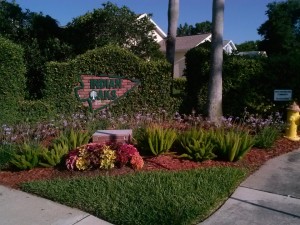Adding annual flowers to your landscape is a great way to bring fabulous bursts of color to your garden, even though they are usually temporary. Annuals are seasonal plants, that are sometimes called bedding plants, and they are narrowly defined as plants that grow, and reproduce (which means to flower) and die, with a one year time frame. In the landscape world, then, when they are flowering, they are at the peak of their life when you buy them, and will only live for a few more months, in your garden. Most annual plants are designed to live for 3 or 4 months after purchase, with the expectation that they will be replaced out, seasonally, with another annual of a different type, that prefers the new season. With that in mind, adding annuals to your landscape can bring a wonderful pop of color, seasonally, with an expected rotation of changing them out 3-4 times a year, given their limited lifespan and preferred season.
Adding annuals to your landscape can bring a wonderful and changing variation to the look of your landscape, but it is not for everyone. While some annuals can be low maintenance and seem to free-seed and live on their own, others can require dead-heading of old seed pods and pinching back when they get leggy and spindly. More so, most annuals have a preferred season, and do require a rotational change-out. However, if you are willing to do the work, no matter how large or small the designated area for planting, you will rarely find the colors to add to your landscape, that annuals can bring. They bring vibrant colors in a big way on a small scale, that no other plant can do!
If you do decide to add annuals to your landscape, here are a few tips:
- Annuals always will need a bed of fresh potting soil to be planted in. Do not plant them in regular Florida soils and expect success.
- If you want to mulch your annual bed, do not mulch the annual. Leave a 1" clearance around the stem of annuals, and only lightly mulch the soil bed, as most annuals are very sensitive to materials around their stems and can die from root rot or too-deeply planting.
- Know the preferred season for your annuals. Many nurseries and almost all box stores sell annuals (and vegetables) out of season. A smart man told me recently that he simply watches for what annuals are planted at the subdivision entrances and commercial buildings, and he follows suit. He is absolutely right and this is an awesome way to get it right the first time. The pros are not guessing about the right season/ right annual.
- Some annuals are more prone to insect and fungal problems, so if you opt to select those plants that are, stay vigilant with your pest control, for ultimate success.
- Lastly, as always, have fun with your landscaping and don't give up! I don't believe in black thumbs, and some plants just have rules or natures that have to be followed. Follow them! and you will be successful.
As a note, and as a landscaper, I do not install many annual beds, but when I do, this is my philosophy:
- Keep the bed small, within 1-2 trays of plants, always in a bed of potting soil
- I prefer a 3 time a year rotation: Begonias in the spring, as they can handle the heat, but hate the rain; Coleus in the mid-summer as they love the rain and the heat; Petunias in the winter, as they can handle some heat but love the cold.
There is so much to know about gardening and landscaping, and IFAS is the source. For more information about annuals, and seasonal tables, click on this link:
http://edis.ifas.ufl.edu/mg319
Let's get gardening, Folks!
Donell

